6. What the Numbers Mean
Since their inception around the time of our Civil War, metallic cartridges have been labeled for their dimensions. But the numbers don’t all refer to the same dimensions. Also, units of measure can vary—inches and millimeters, for example. Other numbers can be thrown in: year of origin, bullet weight, even bullet speed. Sometimes numbers are rounded up or down so as not to duplicate numbers already in use. ]
Best to start at the beginning. Labels on boxes of rifle cartridges usually specify bore diameter and parent firm (originator), plus the name of the manufacturer. So you’ll find .243 Winchester ammunition loaded by Remington and .257 Roberts cartridges by Federal. Numbers designating caliber can confuse because in rifled barrels there are two diameters: one for the bore and one for the grooves cut to spin the bullet. The bore diameter (measured across the lands between grooves) is smaller than the groove diameter, and either number could be used as “caliber.” The .250 Savage and .257 Roberts, for example, have bullets of the same diameter: .257 inch. That’s groove diameter. Both .250 and .257 rifle bores have a .250 land diameter. The .270 Winchester is .277 across the grooves; all .300s mike .308 across the grooves, as do the .308 Winchester and .308 Norma Magnum. Centerfire .22’s, from the .218 Bee to the .225 Winchester, use the same .224 bullets. Bullets for the .303 British measure .311. Those for modern .338’s and Weatherby’s .340 Magnums mike .338 for the .350 Remington and .358 Norma Magnum’s .358.
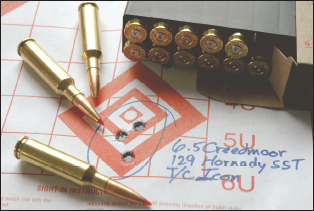
T/C’s Icon has a reputation for accuracy. So does Hornady’s 6.5 Creedmoor cartridge.
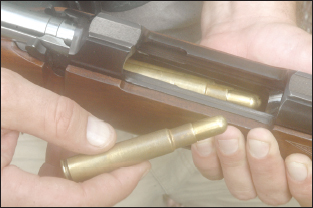
The .416 Rigby is still popular after its first century. This hunter is loading a CZ rifle with solids.
What about two–digit designations like the .22 Hornet, .30 Carbine, and .45 Colt? These numbers simply indicate bore diameter in hundredths, not thousandths of an inch. Add a zero, and you’ll often come up with the name of a similar cartridge and a good idea of the bullet diameter. Sometimes the rule doesn’t hold, though. Handgunnners know the .38 Special uses the same .357 bullet as the .357 Magnum! Two two–digit numbers usually mean the cartridge dates to black powder days, the second pair indicating grains of black powder in an original load. The .45-70 was charged with 70 grains of black powder before it climbed aboard the smokeless wagon. Of course, “grains” here is a weight measure, not a physical description as in “grains of sand.” There are 437.5 grains in one ounce. The best–known exception to the paired double–digit tradition is the .30-06. This is a .30 caliber cartridge adopted by the US Army for its new Springfield rifle in 1906. It replaced the .30-03. Another anomaly: the .250-3000 Savage. Developed by Charles Newton for Savage around 1913, it featured an 87–grain bullet at an advertised speed of 3,000 feet per second. The company wanted that velocity (high for that day) in the cartridge name. Some old cartridges wear a third set of numbers, designating bullet weight in grains, as in .45-70-405, a designation for the official US Army cartridge from 1873 to 1892. Three number sequences can also show caliber, bullet weight, and case length, as in .45-120-3 ¼ Sharps. The 3-¼ inch case is exceptionally long.
In Europe, rifled bores are commonly measured in millimeters, not hundredths of an inch. Some American rounds have been labeled this way. The 6mm Remington uses a .243 bullet, the 6.5 Remington Magnum a .264 bullet (like Winchester’s .264 Magnum). The various 7mm’s fire .284 bullets, the 8mm Remington Magnum a .323 bullet. European cartridge designations also include case length in millimeters: The 7x57 Mauser has a 7mm groove diameter and a case 57mm long. Our .308 Winchester cartridge is known in military circles as the 7.62x51 NATO (51mm is the case length).
“Wildcat” cartridges are those not commercially manufactured but fashioned by handloaders from existing cases. The .338-06 is the .30-06 with its case “necked up” to .33 caliber. Some wildcats, notably the .25-06 and .22-250 (on the .250 Savage case), have gone commercial. For years, hunters handloaded the .35 Whelen, a .30-06 derivative named after Colonel Townsend Whelen, a firearms authority in the decades between the world wars. Remington began producing .35 Whelen rifles and ammunition in 1988. Long-range enthusiasts necked the never-popular .284 Winchester hull to 6.5mm and liked it so well that Norma now loads it. Many commercial rounds have other cases in their ancestry. The 7x57 Mauser, circa 1892, was revamped to produce the .257 Roberts and, later, the 6mm Remington. The .308 Winchester case fathered the .243 and .358. Remington’s 7mm-08 and .260, and the .338 Federal, later joined that group. The 7-30 Waters is a .30-30 case blown forward and necked to .284.
The selection of rimfire rounds has also grown of late. (The priming compound in rimfire lies in the rim itself instead of in a separate, central primer). The patriarch of this family could be the .22 BB Cap, designed in 1845 for what were then known as parlor or saloon (salon) rifles. The “BB” stands for “bulleted breech.” This round initially held no powder; the priming alone delivered enough thrust for indoor target shooting. During the 1880s the CB (conical bullet) Cap appeared, loaded with 1-½ grains of black powder. The .22 Short and Long appeared early too. They differ in case length. Originally, the Long Rifle had the Long’s case but a heavier bullet: 40 grains compared to 29. A 37-grain hollow point followed. Now some hyper-velocity .22 Long Rifle rounds feature bullets of 33 to 36 grains. The .22 Special is dead, but not the .22 WMR (Winchester Magnum Rimfire), available in a variety of loads and bullet weights. Hornady’s wildly successful .17 HMR is based on that hull. The logical follow up, the .17 Mach 2 (also by Hornady, on the .22 Long Rifle case) has not achieved the HMR’s success at market. Still, both give tiny (20-grain) bullets a very fast start.
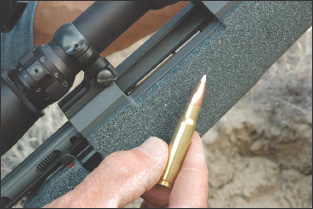
Based on the .308 Winchester, the .338 Federal offers greater efficiency and more bullet weight.
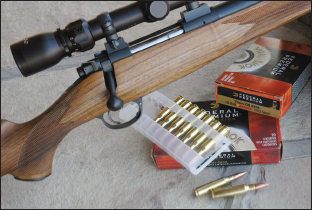
At just 6 pounds, Kimber’s 84M is still pleasant to shoot in 7mm-08, a fine plains game cartridge.
The term “magnum” means a cartridge boasts extra-high energy or velocity. But some magnums are not as potent as others with the same bore diameter. Some rounds not called magnums (though they may come from magnum cases) outperform cartridges that carry the magnum label. Remington’s 7mm STW (Shooting Times Westerner) derives from the 8mm Remington Magnum and has a bigger case than the 7mm Remington Magnum. “Belted magnum” refers to the belt in front of the extractor groove, present on cartridges based on the .300 H&H case and, later, the .378 Weatherby. Almost all belted magnum rifle cartridges were fashioned from the .300 H&H, itself an offshoot of the .375 H&H, circa 1912. The belt is a headspacing device; it has essentially nothing to do with structural reinforcement. The belt is a stop, to be arrested by the chamber to ensure proper fit between case, chamber and bolt head. The rim on a .30-30 hull, and the shoulder on a .270, perform the same function. All prevent the case from entering the chamber too far. End play in a chambered round can result in case separation on firing. Incidentally, magnum handgun rounds like the .357 and .44 magnums are much smaller than the .300 H&H and aren’t belted.
“Nitro Express” is the British equivalent of “magnum.” The name derives from nitroglycerine, the explosive used in some gunpowders and evokes images of a fast moving train. Mainly it applies to rifle cartridges designed for thick skinnned African game. “Black Powder Express” predated it, during the late 1800s. By the way, dual numbers on British cartridges signify parent cartridge and bore, in reverse order from American custom. A .450/.400 fires a .400 (actually .405) diameter bullet.
A word about shotshell nomenclature: Gauge is an early measure of bore diameter, indicating the number of lead balls the size of the bore that equal a pound. So the bigger the bore, the smaller the gauge. Balls that fit a 16 gauge shotgun bore weigh an ounce apiece; those that fit a 20 gauge weigh less because the bore is smaller in diameter and more small balls are required to equal one pound. An exception is the .410, actually a caliber designation: .410 inch bore diameter. The .410 is equivalent to 67-½ gauge. You can substitute “bore” for “gauge” when referring to a shotgun, as in “a 12 bore double.” Common shotgun gauges are 10, 12, 16, 20 and 28. During the late nineteenth century, “punt guns” of 4 gauge and even larger were mounted in small boats to kill waterfowl for market. Early African explorers used 1,250-grain bullets in 8 gauge muskets, delivering 3 tons of energy to big game, even at the sedate speed of 1,500 feet per second!
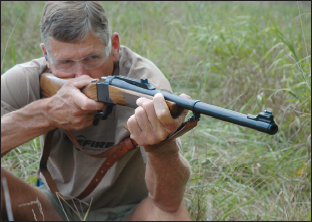
Wayne fires a Ruger No.1, an elegant rifle that employs a dropping-block action much like the one John Browning used in many of his designs.

This fine buck fell to a 412 yard shot with a GreyBull-stocked Remington 700, 7mm Magnum.
Labels on shotshell boxes show powder charges in “drams equivalent,” the designation dating to black powder days. A dram is a unit of weight; 16 drams equal one ounce. When smokeless supplanted black powder at the turn of the century, it was of a type known as “bulk powder” and could be loaded in place of black “bulk for bulk” (not by weight). “Dense” smokeless powders came later. They took up less space in the shell, so neither bulk nor weight equivalents applied. A “3-¼ dram equivalent” charge is a smokeless charge that approximates the performance of a 3-¼ dram black powder charge. It has nothing to do with the amount of smokeless powder actually loaded. The other numbers on a shotshell box refer to shot charge weight and pellet size. A series that reads “3-¼—1-¼—6” tells you there’s an ounce and a quarter of #6 shot in each shell.
Magnum shotshells may be longer than standard shells or may just have a heavier charge of shot. Standard length magnum shotshells commonly carry extra heavy payloads at modest velocities.
Table of contents
- Title Page
- Dedication
- Copyright
- Acknowledgments
- Foreword
- CONTENTS
- INTRODUCTION
- SECTION I: BALLISTICS IN HISTORY
- SECTION II: THE MUSCLE BEHIND THE SHOT
- SECTION III: BULLETS—THE INSIDE STORY
- SECTION IV: SPEED, ENERGY, AND ARC
- SECTION V : PUTTING BALLISTICS TO WORK
- SECTION VI: FOR LONGER REACH
- BALLISTICS TABLES FOR MODERN SPORTING RIFLES
- GLOSSARY